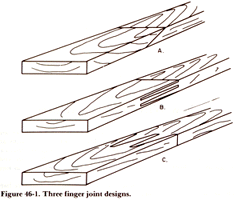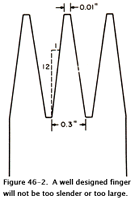by Professor Gene Wengert
Editors note: The following article is an excerpt from the book "The Wood Doctor's Rx," by Gene Wengert, retired Professor and Extension Specialist in Wood Processing, Department of Forestry, University of Wisconsin-Madison.
With a wood resource that has less than high quality, many firms are looking at new species that are less expensive and at lower grades that can still fill the bill. They are considering also finger jointing: that is, the end-to-end gluing of short pieces that have several tapered "fingers" into long pieces.
The end grain of wood is so porous that good end-grain gluing can only be achieved by having mostly exposed side or edge grain. Properly made joints can easily exceed 85% of the strength of clear wood.
The benefits of finger joints in furniture and cabinet manufacturing are: 1) clear lumber from low grade stock, 2) less short length or waste material, and 3) increased yield of usable long parts. On the other hand, finger jointing does require investment in equipment, adhesives, and labor, and the reduced waste can eliminate an energy source, although as energy, wood is worth only $25/MBF. Furthermore, the joint itself may be considered by some to be unattractive and drastically inferior to solid wood. (But it's not!)
Finger joints have been in use in production for more than 50 years, yet it is only with the decline in resource quality that interest in them for furniture has increased. The joints can be made with only one finger (then it is called a scarf joint - Figure 46-1A), vertical (Figure 46-1C), or any in-between orientation.

The finger joint design is usually based on a desire to achieve high strength. Best strength performance seems to be achieved with a slope of 1 to 12, with a thin tip of 0.01 in. (but not so sharp or not so thin as it may break in handling), and a base or root width (sometimes called the pitch) of 0.3 in. (Figure 46-2). These three factors combine to yield sufficient area on the fingers for a good, strong joint without weakening the wood fingers themselves. Naturally the wood species and the basic strength of the wood itself around the joint are important, too.

The steps in making a joint are:
1. Plane at least one edge of the lumber smooth so it can serve as a reference surface,
2. Square the ends of the lumber (including cutting to the correct length in some machines),
3. Form the fingers with cutting tools, by dies (often hot dies) that are forced into wood, or by a combination of these two (accuracy of +0.003 in. is required for high strength).
For a strong joint, the machining tolerances, wood moisture contents, and glue spread rates must be well controlled. Adhesives used for interior, nonstructural joints are melamine-urea, urea, and PVA. For structural joints such as laminated beams, phenol-resorcinol, resorcinol, and melamine adhesives are used.
Certainly it is obvious that the cost of finger jointing will vary from one operation to another. Important cost items include equipment costs, operating costs (mostly labor), direct costs (primarily adhesive and power), and raw material costs (usually the value of the wood is as residue).
Professor Gene Wengert is Extension Specialist in Wood Processing at the Department of Forestry, University of Wisconsin-Madison